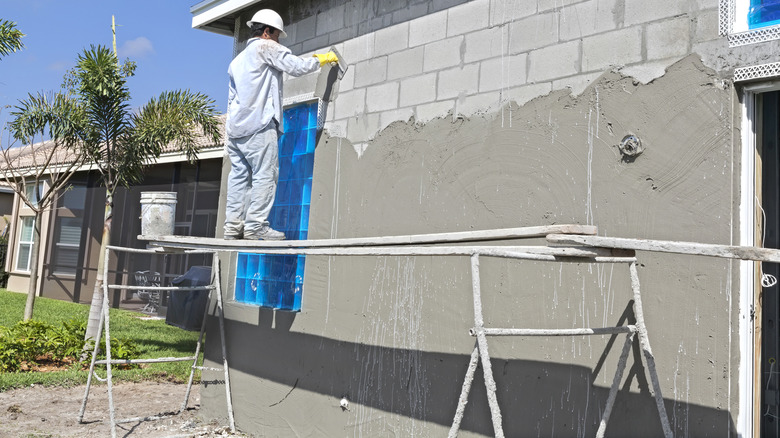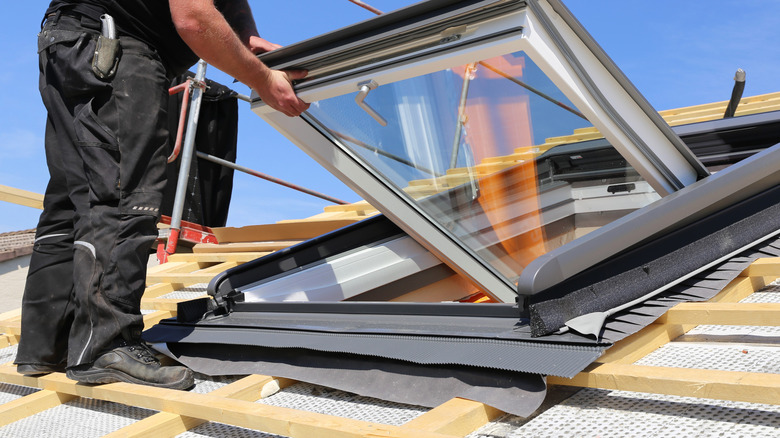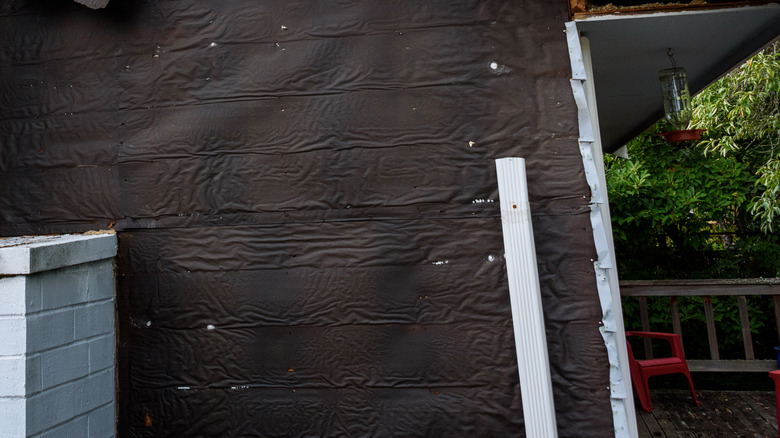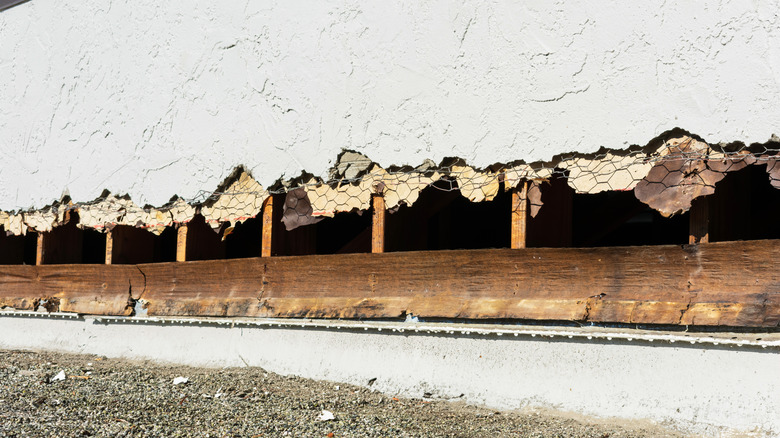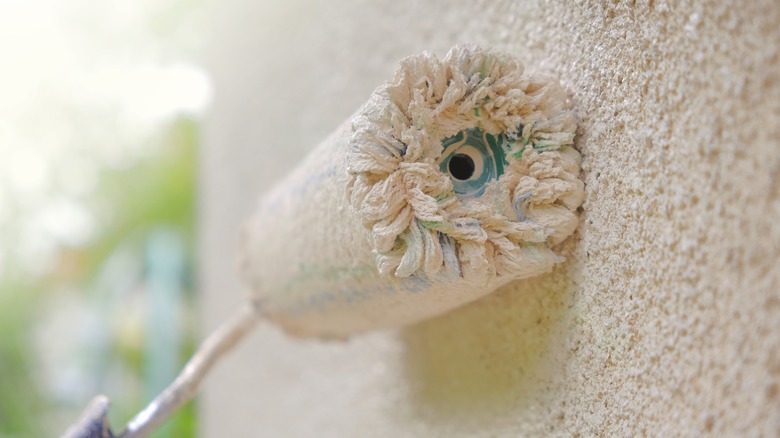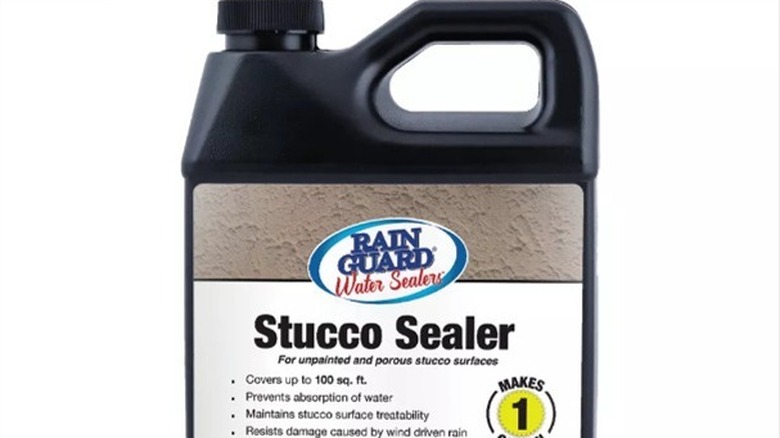All You Need To Know About Waterproofing Stucco
Stucco is a sturdy material known for its durability and longevity with proper maintenance. However, it's not completely waterproof due to its permeability. Nonetheless, if you don't add the extra protection, you'll be doing extensive repairs to the siding and, in the worst-case scenario, to the exterior wall. Thus, additional layers of protection can work in tandem with each other to waterproof your stucco walls.
In this article, we'll dive into the ins and outs of various materials installed prior to applying the stucco, like flashing, water-resistant barriers, the lathing, and the weep screen — all of which keep moisture away from the outer finish and the wall itself. We'll also look at materials, such as paint and sealer, that can be applied as an additional shield against rain and ice once the stucco has been completely cured and dried. Knowing what your options are can better enable you to take the steps toward waterproofing your stucco walls.
Flashing installation is vital
Flashing makes a big difference in protecting stucco from moisture. Window and door frames prove to be problematic for stucco if their flashing is not properly installed. The areas where frames meet the wall have a tiny opening where water can enter and eventually come in contact with the exterior wall, thus causing it to deteriorate. To avoid this, you would need to ensure the flashing is situated underneath the weather-resistant barrier.
Flashing for door frames bears equal importance but is sometimes overlooked during the construction process since they don't have flanges like window frames. However, you can secure an adhesive membrane flashing around the door jamb and a metal drip cap flashing over the trim to keep moisture from seeping in.
Likewise, the proper flashing installation around vents, plumbing, or any other wall openings is imperative for keeping stucco as waterproof as possible. These areas require extra protection since they're exposed to outdoor elements that would otherwise damage caulking and sealants. Therefore, any small slot that allows moisture to enter beneath the stucco should be flashed to save wear on the siding and exterior walls.
WRB: the exterior wall's protection
Any building material, from wood to brick, requires some water-resistant barrier (WRB), but in the case of stucco, it's vital to the veneer's longevity. So, the best option for waterproofing the surface is to steer clear of paper backing lathing. It doesn't provide a sufficient barrier between moisture runoff and the stucco and tends to wear down as years pass. Plus, some contractors might use nails to attach the lathing to the surface, which weakens the backing.
Instead, you need a barrier with the appropriate permeability that allows for just enough airflow for evaporation to place — which also guards the stucco against damaging water accumulation. Moreover, there are varieties that you can roll onto the substrate after careful preparation of the surface. However, you must apply the right amount according to the manufacturer's specifications.
Furthermore, you might consider installing a rain screen in addition to the WRB and the lathing. This extra layer enables precipitation to drip along the wall without the accumulation that eventually causes cracks in the stucco.
Make sure the water has an exit
In addition to the vertical, flat surfaces, you can enhance your stucco's waterproof quality by creating a pathway for water to drip down and exit the wall without penetrating the layers underneath the finish. The critical areas include any outer edges at the very top and bottom of the walls. If there's no way for water to escape once it enters the wall, then the stucco will start to crack.
Another consequence is the rotting of the exterior wall underneath the WRB, along with mold development due to prolonged exposure to moisture. This situation results from adhering the stucco directly to the concrete on the wall. Those spots with caulking are a barrier that keeps the water from trickling out the other end.
For this reason, installing a weep screed on the wall's base prevents water from becoming trapped. It keeps water from getting stuck in a highly vulnerable area between the bottom and the foundation. Plus, you must ensure that the flashing between the wall and the roof gives enough coverage to both sites. Otherwise, water would fall into the gaps between the roof and the wall and possibly get absorbed into the underlying materials.
Paint offers some protection
As you can see, the materials underneath the stucco exterior, along with their proper installation, offer optimal protection against moisture. Nonetheless, you might wonder if anything can be done about the outward-facing surface. Painting the stucco can provide this protection to a certain degree, but you need the elastomeric variety that also possesses the quality of breathability. This type has a consistency that's thicker than your average exterior paint, which means that ideally, you should use this paint by itself and not in a situation where you already have more than one coat of paint on the surface.
Another alternative is to paint the surface with waterproof acrylic paint that's specifically created for covering masonry. Still, this choice may be ideal for areas where precipitation and temperature changes aren't too much of a concern. The reason is its lack of waterproofing properties compared to the elastomeric type, but multiple coats offer some protection.
Clear stucco sealer offers a solution
Yet another way to waterproof your stucco is to apply a clear sealer over the paint. Before you take this step, however, you might need to get some advice from a professional paint contractor about the condition of the current finish and what type of paint was used — if you weren't the one who completed the project. A sealer would work more effectively if applied on a well-maintained surface where the paint hasn't peeled, or moisture hasn't already settled in.
Regardless, in conjunction with your choice of paint (once it's completely dry, of course), a sealer would be beneficial for preserving and waterproofing your stucco walls, especially in humid climates or regions that get a lot of precipitation. It guards against moisture and protects the stucco from temperature changes. Additionally, a stucco sealer fills the crevices and holes generally forming in the material, further repels water and fine particles that may harm the stucco.
